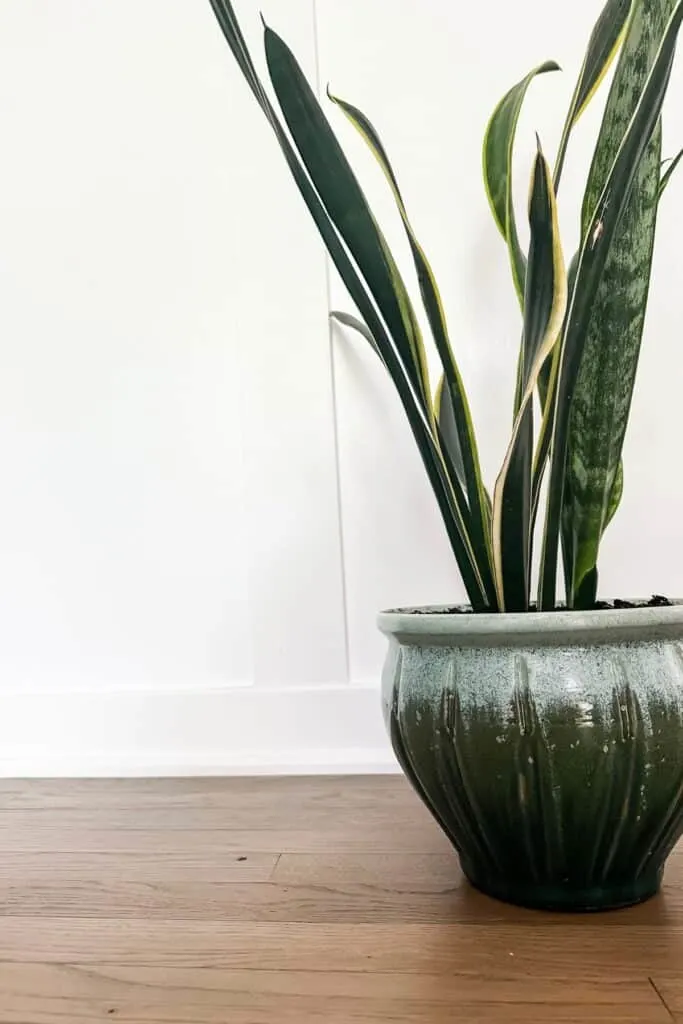The Snake Plant, also known as Mother-In-Laws Tongue, is a popular and hardy plant that is really easy to care for. It’s one of the easiest plants to grow. Here is everything you need to know about Snake Plant Care!
This plant is very popular and it’s not hard to see why. It’s super easy to grow, great for beginners and looks good in almost any area of your home.

*This post contains affiliate links. For more details see my full disclosure.
About Snake Plants
Dracaeacna Trifasciata also known as Snake Plant is a popular and easy to care for plant. It is native to Southern Africa and has adapted well to the climate of the southern United States. Here the plant does well in zones 8 or higher when grown outdoors. However, it can be invasive so it’s best to keep it in a contained area.
The Snake Plant has stiff sword-like leaves that grow from 6 inches to 12 feet. When grown indoors it typically only grows to about 2 feet tall. They do very well in full sun to low light areas but a few hours of morning sun will help the plant to grow faster.
Snake Plant Care
Snake plants are one of the easiest plants to care for which makes them great for beginner gardeners. They are hardy in zones 8-11 when planted outside but make one of the most popular houseplants.
How to Plant Snake Plants
Make sure you use a well-draining potting mix. A mix intended for cacti and succulents is best for Snake Plants.
Make sure the pot you use has drainage holes in the bottom.
When repotting, don’t plant the Snake Plant too deep in the soil. Make sure you are putting it about the same distance in the soil as the plant had been previously.
The Best Place to Put Snake Plants
Snake Plants thrive in almost any type of light situation. They are a popular plant for office buildings because of this.
That being said, they do thrive in bright indirect light. They can even tolerate a few hours of direct sunlight. Snake Plants can tolerate low levels of light but they will grow more slowly in this environment.
Water
The Snake Plant is considered a succulent so do not overwater. This is the easiest way to kill a Snake Plant.
Let the soil dry out between watering then water thoroughly. Typically you only need to water every two weeks during the growing season and once a month in the winter. If the leaves start to dry out water right away.
Do not allow the soil to get soggy. The plant can develop root rot if it sits in too much water. If you notice yellow leaves then the soil might be too wet.
Light
As I mentioned, this plant likes bright indirect light. About eight to ten hours a day. It can tolerate a few hours of direct sunlight but too much can burn the leaves.
It does well in low light but the leaves can lose their vibrant color and the growth might be slower. To keep your Snake Plant healthiest make sure it gets a few hours of sunlight every day.
Soil
Snake Plant prefers a well-draining soil so a mix made for cacti or succulents is best. Avoid soil mixes that have a lot of peat as this can retain moisture. This plant prefers a more sandy soil.
Temperature and Humidity
Snake Plants do not do well in temperatures below 50 degrees. They need temperatures to be between 70 and 90 degrees Fahrenheit. Also, keep them away from drafts.
They prefer a humidity level between 30 and 50 percent.
Fertilizer
Fertilize in the spring as well as mid-summer. Do not fertilize in winter.

How to Propagate Snake Plants
There are several ways to propagate Snake Plants. You can divide the plant at the root, propagate from leave cuttings in water or soil, and do rhizome propagation.
Root Propagation
- Remove the plant from the pot and brush off any loose soil
- Using a sharp clean knife divide the leaves keeping the roots intact.
- Plant in the new pot with soil intended for cacti and succulents.
- Water thoroughly and place in a sunny spot.
Propagate leaf cuttings in water or soil
- Using a sterile cutting tool remove a leaf at its base.
- Place the cutting in water or allow it to callus and place it in soil made for cacti and succulents.
- It can take up to four months for a new leaf to grow in water. Make sure you refresh the water every two weeks.
Rhizome propagation
- Remove the plant from the pot and brush off any loose soil
- Using a clean sharp cutting tool cut the rhizome from the base of the plant near the root system.
- Allow the rhizome to callus.
- Replant in a new pot.

Potting and Repotting a Snake Plant
The best time to repot is in the spring. When your Snake Plant has outgrown the original pot or the roots become overcrowded then it’s time to repot.
Make sure the new pot is wide and shallow and twice the size of the root ball. Don’t put the plant deeper in the soil than it was in the original pot. The best pots to use are ceramic or terra cotta because the strong roots can break plastic pots.
Diseases and Pests
Root Rot is the most common disease that Snake Plants encounter.
The common pests are typical of houseplants and can include scales, gnats, spider mites, aphids, and whiteflies. Treat these infestations with neem oil
Common Problems
Root rot is the most common problem with Snake Plants due to overwatering. If this happens allow the plant to dry out longer than usual. If the plant still isn’t thriving remove from the pot and discard any rotten roots and leaves then repot.
Other Plant Posts You Might Like:
- The 30 Best Pet-Friendly Plants That Are Safe For Cats and Dogs
- The 31 Best Houseplants for Beginners
- 14 Plants and Trees That Repel Mosquitos
- The 13 Best Deer Resistant Plants and Flowers


Snake Plant Care
As a licensed Real Estate Agent and an avid home decorator, I strive to give my clients the very best I can when it comes to staging, selling, and decorating their homes. I have lots of experience with paint color choices and love to DIY my home so I can have everything just the way I want it. I share my ideas and projects with the world in the hopes that I can help others have their homes just the way they want as well.

